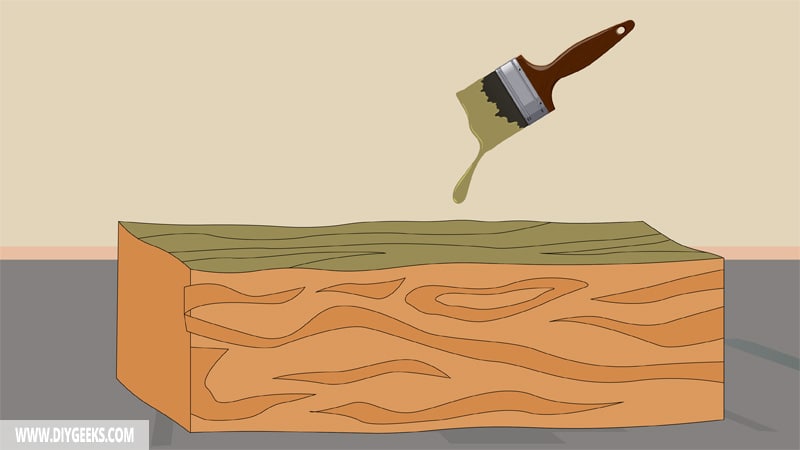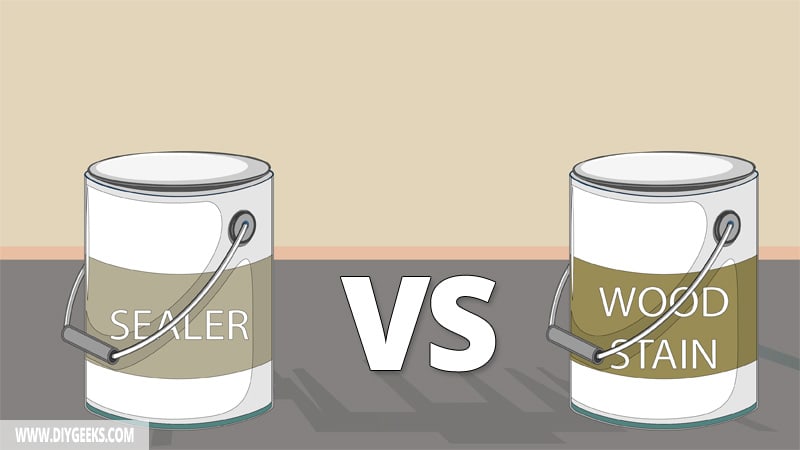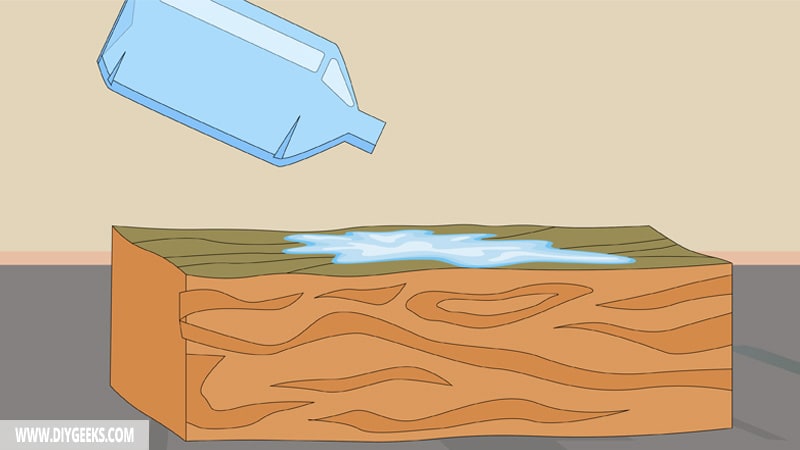No, wood stain doesn’t protect wood from moisture, water, scratches, or UV lights. It only offers minimal protection from dust, debris, and handling.
To make a stained wood waterproof, apply two (2) sealer coats over the finish (after it has dried).
How Does Wood Stain Protect Wood?

Wood stain protects wood by penetrating and covering its surface, and creating a thin layer that protects it from dust, debris, and handling.
It also changes the wood color to a darker shade because of the high level of dark pigments in its formula. The wood will become darker once you apply wood stain over it.
Wood stain doesn’t protect wood from moisture, water, or scratches because it doesn’t have protective additives in its formula, and penetrates the surface pores without creating a thick layer over it.
Wood stain formula consists of pigments (or dye), solvent (water or oil), and binder. None of these additives protect a surface.
However, “Stain & Seal” products protect the wood from UV lights, moisture (or water), and scratches, and will alter its color. “Stain & Seal” products are a combination of stain and sealer, they come in different colors, and will last for approximately 10 years.
To protect a stained wood, apply two (2) sealer coats over the surface. The sealer produces a thick and glossy protective layer that will shield the surface from moisture, water, scratches, and UV lights. We recommend varnish or polyurethane as a sealer.
Related Read: Can You Apply Varnish Over Stain?
Staining vs. Sealing (For Wood)?

Staining and sealing wood are two different things. When you seal it, you use a stain-blocking and moisture-resistant sealer that protects the surface from moisture, water, UV lights, and scratches. The sealer doesn’t penetrate the surface; instead, it stays on top of it.
When you stain, you use a highly pigmented stain that will alter the shade of the wood. The purpose of staining is to improve the beauty and color of a surface, not to protect it.
But, who’s better for wood? Stain or sealer?
In terms of beauty, staining wood is better because the stain is designed with colorants or paint pigments to alter the color and shade of the surface. When dry, the stain produces an attractive and colorful finish.
Sealing doesn’t offer an attractive finish. Most sealers don’t have pigments in their formula and dry to form a clear and glossy finish. This will get boring to look at after a while.
In terms of durability, sealing is better because it protects the surface from moisture, dents, and even UV rays. In addition, when sealers dry, they form a moisture-resistant and thick film that prevents moisture (or liquid) from penetrating its coating. This gives the surface improved durability and resistance against factors that can damage it.
For indoor decorative wooden surfaces, use wood stains as they don’t need much protection. For outdoor surfaces, use sealers because the stain isn’t durable enough to withstand weather elements. You can also apply stain and then seal it with polyurethane or spar varnish.
Does Wood Stain Protect Wood from Rotting?
Wood stain doesn’t protect wood from rotting as it isn’t waterproof and doesn’t repel moisture.
Rotting wood is caused by moisture, fungi, pest infestation, and mold growth. A stain coating doesn’t protect the surface from any of these.
To prevent wood from rotting, the finish must be moisture-resistant and thick enough to prevent termites and bugs from burrowing into it. Wood stain is prone to all these and won’t protect the surface from them.
To protect stained wood from rotting, apply two (2) coats of sealer over the surface. The sealer will produce a protective layer over the surface. You can also use “Stain & Sealer” products.
Does Wood Stain Waterproof Wood?

Wood stain doesn’t waterproof wood as it’s water-soluble and will dissolve if exposed to enough water.
The wood stain finish will peel off from the surface and water will penetrate the wood pores if it’s exposed to enough water. That’s because wood stain is made of colorants, solvents, and binders, and doesn’t have waterproofing additives or a glossy layer that repels moisture.
“Stain & Sealer” products are waterproof because they are produced by a mixture of sealer and wood stain. This product will alter the wood color and simultaneously waterproof it.
You can also manually add two (2) coats of sealer over the stained wood to make it waterproof. We recommend varnish or exterior polyurethane.


